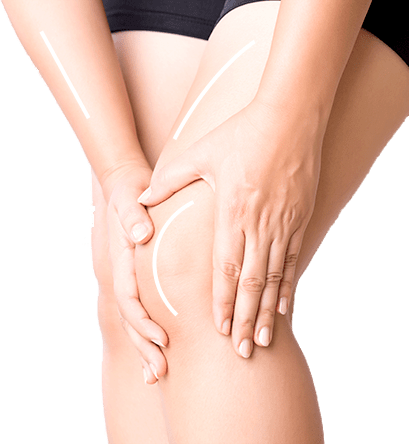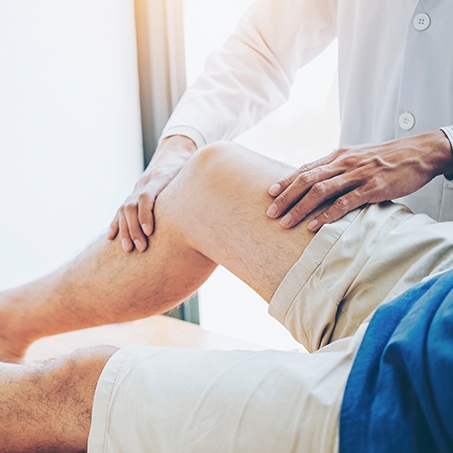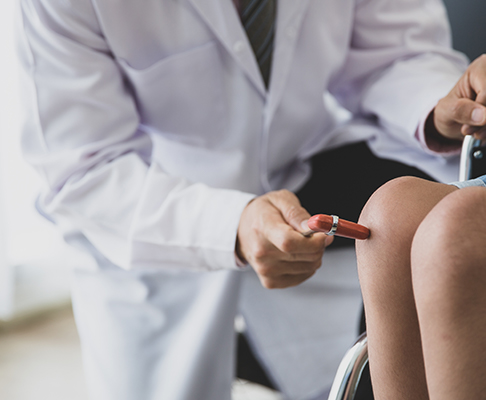Knee Pain
Knee Pain & Causes
Knee pain is a common complaint when visiting the doctor. The pain can originate from within the knee joint or outside the knee joint. The causes of knee pain are varied: ranging from sudden injury due to a torn cartilage or a ruptured ligament, to an overuse injury or an underlying condition such as arthritis, gout or infections.
This pain can be triggered by other problems such as back conditions or a foot injury and can be aggravated by physical activity Knee pain can affect people of all ages, and home remedies can be helpful unless it becomes severe.
Knee pain can be caused by injuries, mechanical problems, and types of arthritis.

Knee Pain Caused By Common Knee Injuries
Anterior Cruciate Ligament (ACL) Injury
The severity of the injury can range from a simple sprain to a complex tear. ACL tear symptoms include swelling of the affected knee as well as pain or instability in/of the knee whenever walking, running or climbing stairs.
Fractures
For people with severe osteoarthritis, knee fractures can happen innocuously without any significant trauma. This type of pain is constant throughout, making weight-bearing very difficult on the painful knee.
Patellar Tendinitis
This tendon is a connection for the quadriceps muscle that lies on the front of the thigh to your shinbone. When tendinitis occurs, one or more of your tendons gets irritated and inflamed.
Knee Bursitis
The knee becomes progressively more painful if a patient walks or stands more. Pain related to Knee Bursitis is usually on the inner or middle part of the knee.
Torn Meniscus
Meniscus pain can present similar to fracture pain. It can present itself as locking of the knee when standing after being seated for some time. Other symptoms include finding it It is difficult to initiate standing and walking.
Knee Pain Caused By Mechanical Problems
Dislocated Kneecap
Hip or Foot Pain
Iliotibial Band (IT band) Syndrome
The Iliotibial band (IT band) is a tough band of tissue that extends from the outside of your hip to the outside of your knee. IT band syndrome occurs when the IT band becomes so tight that it rubs against the outer portion of your femur.Those who run long or cycle for long distances tend to be especially susceptible.
This type of pain can be mistaken as radicular pain from buttock to lateral part of the affected knee. It is the pulling and tightness of the left lateral thigh.
This tendon is a connection for the quadriceps muscle that lies on the front of the thigh to your shinbone. When tendinitis occurs, one or more of your tendons gets irritated and inflamed.
Loose Body
A piece of bone or cartilage may end up breaking off and floating in the joint space after injury or degeneration. Although this phenomenon is in itself harmless, it will cause pain when the loose body interferes with knee joint movement.
It can present as a locking knee which has jammed up the movement of the knee. Depending on where the loose body is located, it can have pain-free intervals interspersed with sudden pain.
Knee Pain Caused By Types of Arthritis
Gout
Uric acid crystals build up in the joint to form gout. Most people experience it in the big toe, but it can also occur in the knee. The excessive uric acid build-up in the body accumulates in the knee joint causing a severe inflammatory reaction.
When Gout occurs the knee is often red and swollen. It is painful even when performing non-weight bearing activities such as bending or extending the knee joint while lying in bed.
Osteoarthritis
Also known as degenerative arthritis, this is the most common type of arthritis. Especially common with old age, this happens after the cartilage in your knee deteriorates with use and wear-and-tear.
As one ages, the synovial fluid (lubricant) dries up. This increases friction between the articulating cartilage surfaces of the knee joint. The friction will cause accelerated wearing off of the cartilage, resulting in cartilage thinning and loss. Once the protective layer of cartilage is breached, the underlying bone will swell and inflame with any seemingly harmless weight bearing activities on the knee.
If untreated, the ongoing degeneration of the knee will result in destruction of the knee joint, resulting in pain, swelling and deformity of the knee. This will restrict the normal function of the knee, making it difficult to stand, walk or climb stairs.
Pseudogout
Pseudogout is often mistaken for gout but it is caused by calcium-containing crystals that develop in the joint fluid. Knees are the most common joint affected by pseudogout. It has similar inflammatory signs to gout but the uric acid levels are not elevated.
Rheumatoid Arthritis
This is an autoimmune condition that can affect almost any joint in your body, including your knees.
Although rheumatoid arthritis is a chronic disease, it tends to vary in severity and may even come and go. This is part of the systemic condition affecting many body organs/joints.
Similar to osteoarthritis, the inflammation and end-result of joint destruction is the same. The major difference is that this is immune-mediated and not due to age degeneration.
Septic Arthritis
Septic arthritis can quickly cause extensive damage to the knee cartilage. If you have knee pain with any of these symptoms, see your doctor right away.
This infective cause of painful knee is potentially dangerous and it can progress to systemic sepsis (generalised infection of the body), causing harm to other body organs. Severe localized septic arthritis can even result in loss of limb such as amputation of the leg to save the patient.

Symptoms Of Knee Pain
Due to the varied causes of knee pain, the location and severity of the pain may vary. However, you can watch out for accompanying signs and symptoms that include:
- Swelling and stiffness
- Popping or crunching noises
- Inability to fully straighten the knee
- Redness and warmth to the touch
- Weakness or instability
- Pain when putting weight on the knee
- Pain when walking, standing, or squatting
When Should You Seek Medical Care?
You should seek medical help when:
- You can’t bear weight on your knee or feel as if your knee is unstable (gives out)
- Have marked knee swelling
- Are not able to fully extend or flex your knee
- Have affected sleep due to painful knee
- Notice an obvious deformity in your leg or knee
- Experience a fever, in addition to redness, pain and swelling in your knee
- Experience severe knee pain that is associated with an injury

A Message About Knee Pain
Knee pain may or may not be serious. However some conditions such as osteoarthritis, can lead to increasing pain, joint damage and disability if left untreated. Knee injuries, even minor ones, will predispose you to similar injuries in the future.
Diagnosing Knee Pain
Your doctor will diagnose knee pain with a series of preliminary tests before moving on to further evaluation if needed.
Preliminary Tests
Your doctor will:
Inspect
- Check for swelling, pain, tenderness, warmth or visible bruising
Evaluate Movement
- Move your lower leg in different directions to see how far you can move
Check Integrity
- Push on or pull the joint to check the integrity of the structures in your knee
Further Evaluation
Depending on the results of your preliminary tests, your doctor may further evaluate through these tests:
Computerised Tomography (CT) Scan
Joint Aspiration/blood tests
Magnetic Resonance Imaging (MRI)
Ultrasound
X-ray
What Treatments Are Available for Knee pain
After proper diagnosis, the doctor will prepare the appropriate treatment for your knee pain. Common methods of knee pain treatment can be categorised as non-surgical, surgical and home remedies.
Non-Surgical Treatment for Knee pain
Non-surgical treatments include physical therapy to aid in rehabilitation, the use of supports and braces to relieve pressure or injections to provide pain relief.
Physical therapy
If you are physically active or practice a sport, the therapist will guide you to use exercises to correct movement patterns that may be affecting your knees and to establish good technique during your sport or activity. They may sometimes include exercises to improve your flexibility and balance.
The therapist will recruit and strengthen weakened muscles to compensate for the specific painful area of the knee, offloading the pressure on the injured area.
Knee Supports and Braces
Knee Injections
Knee injections in Singapore are becoming more common.
Medications or other substances may be injected directly into your joint for different types of treatment. Such instances include:
Corticosteroids
A corticosteroid drug may be injected into your knee joint to help reduce the symptoms of an arthritis flare, while providing pain relief that may last a few weeks.
Hyaluronic acid
In order to lubricate your joints, hyaluronic acid can be injected into your knee to improve mobility and ease pain. Effectiveness may vary across individuals but relief from one to a series of shots have been said to last as long as six months to 3 years.
Depending on the severity of the arthritis of knee, the outcome of the visco supplement injections may be as follows:
1. Early arthritis: 5 years sustained outcomes
2. Moderate arthritis: 2 – 5 years
3. Late arthritis: 6 months or less
Platelet-Rich Plasma (PRP)
PRP injections are commonly used for pain caused by a torn meniscus as well as conditions such as osteoarthritis. The injection sites include the meniscus and surrounding ligaments.
Myospan treatment addresses both local and referred causes. Our Coreflex injections use a mix of local anaesthetic, anti-inflammatory and muscle relaxant, to be injected into the affected knee as well as any strained surrounding meniscus and ligaments.
Surgical Treatments for Knee Pain
is important to consider the pros and cons of both nonsurgical rehabilitation and surgical reconstruction before deciding to go under the knife.
If you choose to have surgery, your options may include:
Arthroscopic Surgery
Arthroscopy may be used to remove loose bodies from your knee joint, remove or repair damaged cartilage (especially if it is causing your knee to lock) and reconstruct torn ligaments.
It also cleans up the inflamed area and hence alleviates the pain. However, this does not reverse the degeneration.
Partial Knee Replacement Surgery
Total Knee Replacement
Home Remedies for Knee Pain
Over-the-counter Medication
Other specific prescription pain creams contain a numbing agent or analgesic, such as lidocaine, salicylate or capsaicin might be more effective and more targeted at reducing pain and swelling.
Rest, Ice, Compression and Elevation (RICE)
Cut down on activities that will cause repetitive strain on your knee and give it time to heal and prevent further damage. A day or two of rest may be all you need for a minor injury. More severe damage is likely to need a longer recovery time.
Ice
Ice is helpful in reducing both pain and inflammation. You can try using a bag of frozen peas because it covers your whole knee. Alternatively, you also can use an ice pack wrapped in a thin towel to protect your skin. Although ice therapy is generally safe and effective, don’t use ice for longer than 20 minutes at a time because of the risk of damage to your nerves and skin.
Compression
Look for a compression bandage that’s lightweight, breathable and self-adhesive. It should be tight enough to support your knee without interfering with circulation. This helps prevent fluid build-up in damaged tissues and maintains knee alignment and stability.
Elevation
To help reduce swelling, try propping your injured leg on pillows or sitting in a recliner. Keeping the knee slightly bent at rest is more effective than keeping the knee straight.
Heat
Alternative Medicine for Knee Pain
Glucosamine and Chondroitin
Acupuncture
This traditional Chinese method involves the placement of hair-thin needles into your skin at specific places on your body. Research suggests that acupuncture may help relieve knee pain caused by osteoarthritis.
How Can I Prevent Knee Pain?
It may be difficult to prevent knee pain but some careful measures can be taken to forestall injuries and joint deterioration.
Maintain a healthy weight
Condition yourself for your sport
Get strong, stay flexible
Choose your exercises
Get Your Pain Resolved
Send your enquiries or consult our pain experts today.


